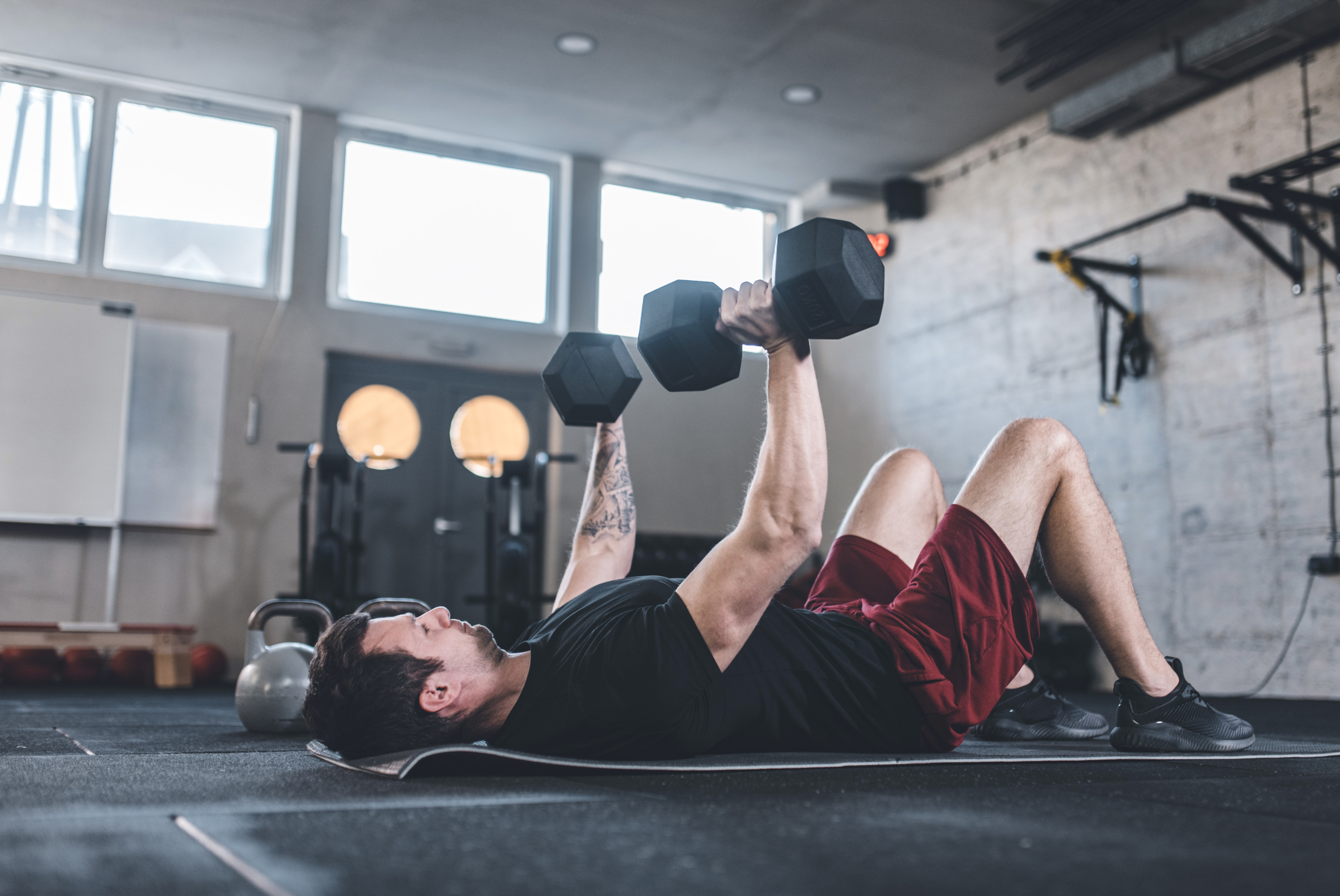
AzmanJaka/E+ via Getty Images
3 Moves for Stronger Chest Muscles
Make the most of your upper body strength with these key chest exercises.
By Kells McPhillips•
All of the Chest Muscles, Explained
The Benefits of Doing Chest Exercises
Types of Chest Exercises
3 Best Exercises for Stronger Chest and Pec Muscles
How and When to Incorporate Chest Exercises Into Your Workout Routine
The chest muscles are the ultimate multitaskers: They help you stand tall, execute functional movements, and perform your workout, sport, or sports to the best of your abilities.
If you’re hoping to take a more mindful approach to your upper body workout, look no further. Peloton instructor Cliff Dwenger has all the information you need to master chest exercises and make the most out of upper body day.
All of the Chest Muscles, Explained
The area of the body we call the chest is actually composed of four major muscles, says Cliff.
The Pectoralis Major (aka the “pecs”): a large muscle group that spans all the way across the chest and under the breast tissue in women. The pecs allow you to move your shoulder and rotate your arms, making them essential for almost any upper body movement.
The Pectoralis Minor: a small muscle that attaches the ribs to the scapula. It helps stabilize and rotate your shoulders.
Serratus Anterior aka The Boxer’s Muscles: fan-shaped muscles located on either side of the body along the ribs. This muscle helps you protract your scapula so you can, say, throw a punch or perform other forward movements with your arms.
The Subclavius: a small muscle that runs along the underside of the collarbone. It stabilizes your clavicle so you can easily move your shoulders.
The Benefits of Doing Chest Exercises
Some people consider chest exercises vanity workouts, but they’re actually a form of functional movement. The pecs, boxer’s muscles, and subclavius provide critical mobility that allows us to perform everyday tasks.
“In all movements that move our arms towards the midline of our body (adduction), the chest muscles are involved,” Cliff says. “We also use them to lift things up—for example, a child from the floor.” He adds that these upper body muscles also allow us to perform push activities, such as opening a door or throwing a punch.
The muscles of the front body also work in tandem with those in your back body to help you maintain proper posture, which is vital for preventing injuries, avoiding back pain, and moving efficiently.
Types of Chest Exercises
Luckily, there’s no shortage of ways to challenge your upper body. Whether you have zero equipment or a room full of dumbbells, barbells, and weight machines, you can strengthen those four major muscles and boost your functional fitness in the process.
Bodyweight
If you’re on the go or prefer to break a sweat without equipment, bodyweight chest exercises such as push-ups, planks, and dips will do the trick.
Dumbbells
Dumbbells allow you to perform exercises such as chest presses. “If the goal is to train the stabilizers of the chest and shoulder muscles, dumbbell chest presses are a good choice as you need to keep the dumbbells in the right position while going through the movement,” says Cliff.
Barbell
You can also use the barbell to perform chest presses. Just make sure that you have someone to spot you if you’re experimenting with higher weights.
Chest Machine
“If you want to get used to the movement pattern and start building stronger chest muscles, the chest machine is a good choice,” says Cliff. This piece of equipment may be especially useful for more advanced weight lifters who want to burn out the muscles of their chest at the end of an upper body session.
3 Best Exercises for Stronger Chest and Pec Muscles
Chest Press
Chest presses are a fundamental chest exercise for increasing bone density, boosting joint stability, and stimulating muscle growth, according to Cliff. Perform them with dumbbells, a barbell, or even a household object (like cans or books). Below, Cliff walks you through how to perform this movement.
With a Barbell
Lie flat on a bench. Plant your feet on the floor. Your eyes should be directly under the barbell.
Grip the barbell with both hands slightly wider than shoulder-width apart in an overhand grip. Press your shoulder blades into the bench. (In this position, you can keep a slight arch in your back throughout the entire exercise to push the ribcage out and better target the chest muscles.)
Lift the barbell off the rack and hold it directly over your chest with your arms extended.
Keep your wrists straight and aligned with your elbows.
Lower the barbell towards your chest. Your elbows should remain at a 45-degree angle relative to your body.
When the barbell almost touches your chest, and your elbows are at a 90-degree angle, push the barbell straight back up. Extend your arms and engage your chest muscles. Repeat this movement. When finished, rack the barbell back onto the rack.

With Dumbbells
Lie flat on your back with one dumbbell in each hand. Plant your feet on the floor.
Grip the dumbbells slightly wider than shoulder-width apart so that your wrists line up right on top of your elbows and your arms are at a 90-degree angle. Keep your arms hovering off the ground.
Lift the dumbbells straight up. Hold them directly above your chest. Keep your wrists straight and aligned with your elbows.
Slowly lower the dumbbells to your starting position and repeat this movement until you’ve completed all your reps.

Push-Up
Push-ups work your core and increase your functional fitness without any equipment. While there are countless variations of this move, the classic exercise is all you need for a great workout.
Start in a plank position, with your hands slightly wider than shoulder-width apart. Align your shoulders, arms, and wrists. Press your palms into the floor. Your body should build a straight line from your shoulders to your hips to your ankles.
Engage your core and activate your glute muscles to maintain this position throughout the entire movement.
Lower down by bending your elbows 45 degrees away from your body and bringing the chest toward the floor. “A good indicator for the depth on a push-up is to stop when your nose almost touches the floor or your elbows are bent at around 90 degrees,” says Cliff.
Once you reach that position, push yourself up into the starting position by pressing your palms into the floor, extending your arms fully, and keeping your chest muscles engaged.
You can make push-ups more challenging by placing a weight on your back or using a band to add resistance to the movement.

Chest Fly
Like other chest exercises, flys increase your range of motion and help and increase your overall upper body strength.
Lie flat on a bench and plant your feet on the floor.
Hold one dumbbell in each hand with an overhead grip, palms facing each other. Your arms should be almost extended, but maintain a slight bend in the elbows. Your arms should be above your chest.
Press your shoulder blades into the bench. From this starting position, lower your arms laterally, maintaining a slight bent in the elbows.
Lower your arms down until they are parallel to your trunk, and you feel a slight stretch in your chest muscles.
Push the dumbbells back up laterally while squeezing the chest muscles together and keeping your elbows slightly bent.
Return to the starting position.
Mistakes to Avoid During Chest Exercises
Make sure to move through exercises that mobilize your joints and prepare your body for the work ahead. A proper warm-up will help you avoid injury and make the most of your workout.
As you perform chest exercises, up the weight you use gradually and carefully. “Do not increase the weight too quickly. This could lead to impingement syndrome, a shoulder injury, or joint injuries in the elbows and wrists,” Cliff explains.
Cliff recommends being particularly careful when performing barbell chest presses. Avoid bending your wrists and excessively arching your lower back, and make sure that you rely on a spotter to assist you with heavier weights.
How and When to Incorporate Chest Exercises Into Your Workout Routine
Cliff recommends working your chest exercises into your upper body days. “Include the chest exercises in an upper body workout, in which you train all the upper body muscle groups: the chest, back, biceps, triceps, and shoulders,” he says.
You can also divide your workouts by “push” and “pull” movements. For example, one day, you may perform chest press and overhead press (push); another day, you may perform pull-ups and dumbbell rows (pull).
Wondering how often you should incorporate chest exercises into your workout routine? Cliff says it really depends on your goals and how comfortable you are with strength training. Here are some general recommendations from Cliff:
Beginner Lifters: Perform chest exercises one to two times per week. Use this time to focus on learning the mechanics of the exercises and opt to lift lower weights with more reps.
Intermediate Lifters: Perform chest exercises one to two times per week. Focus on adding weight while staying in a rep range of eight to 12. You can also start adding more complex exercises and training types like supersets.
Advanced Lifters: Perform chest exercises one to three times per week. Use heavy weights, but only perform a few reps. “The other training days could be used to include more complex chest exercises and variations like incline presses, cable flys, etc.,” says Cliff.

Peloton App
Access thousands of classes with no equipment needed.
This content is for informational and educational purposes only and does not constitute individualized advice. It is not intended to replace professional medical evaluation, diagnosis, or treatment. Seek the advice of your physician for questions you may have regarding your health or a medical condition. If you are having a medical emergency, call your physician or 911 immediately.
Level up your inbox.
Subscribe for a weekly dose of fitness, plus the latest promos, launches, and events.
By providing your email address, you agree to receive marketing communications from Peloton.
For more about how we use your information, see our Privacy Policy.






